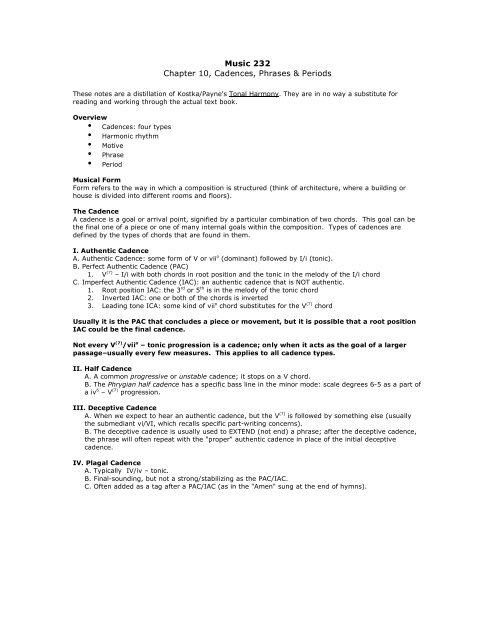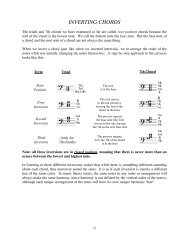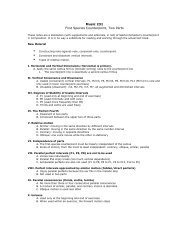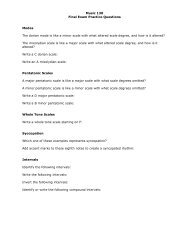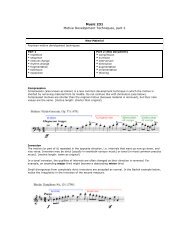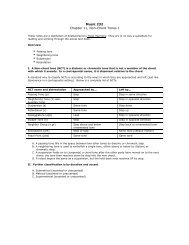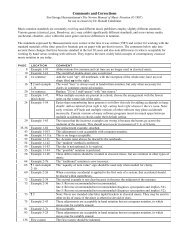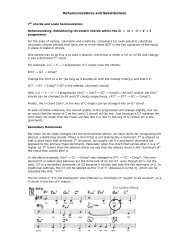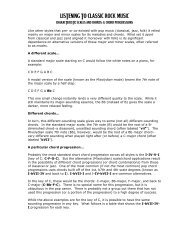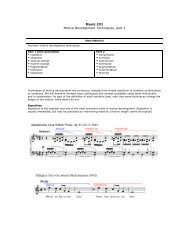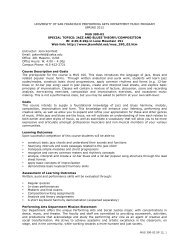Music 232 Chapter 10, Cadences, Phrases & Periods - Jkornfeld.net
Music 232 Chapter 10, Cadences, Phrases & Periods - Jkornfeld.net
Music 232 Chapter 10, Cadences, Phrases & Periods - Jkornfeld.net
Create successful ePaper yourself
Turn your PDF publications into a flip-book with our unique Google optimized e-Paper software.
<strong>Music</strong> <strong>232</strong><strong>Chapter</strong> <strong>10</strong>, <strong>Cadences</strong>, <strong>Phrases</strong> & <strong>Periods</strong>These notes are a distillation of Kostka/Payne's Tonal Harmony. They are in no way a substitute forreading and working through the actual text book.Overview• <strong>Cadences</strong>: four types• Harmonic rhythm• Motive• Phrase• Period<strong>Music</strong>al FormForm refers to the way in which a composition is structured (think of architecture, where a building orhouse is divided into different rooms and floors).The CadenceA cadence is a goal or arrival point, signified by a particular combination of two chords. This goal can bethe final one of a piece or one of many internal goals within the composition. Types of cadences aredefined by the types of chords that are found in them.I. Authentic CadenceA. Authentic Cadence: some form of V or vii o (dominant) followed by I/i (tonic).B. Perfect Authentic Cadence (PAC)1. V (7) – I/i with both chords in root position and the tonic in the melody of the I/i chordC. Imperfect Authentic Cadence (IAC): an authentic cadence that is NOT authentic.1. Root position IAC: the 3 rd or 5 th is in the melody of the tonic chord2. Inverted IAC: one or both of the chords is inverted3. Leading tone ICA: some kind of vii o chord substitutes for the V (7) chordUsually it is the PAC that concludes a piece or movement, but it is possible that a root positionIAC could be the final cadence.Not every V (7) /vii o – tonic progression is a cadence; only when it acts as the goal of a largerpassage–usually every few measures. This applies to all cadence types.II. Half CadenceA. A common progressive or unstable cadence; it stops on a V chord.B. The Phrygian half cadence has a specific bass line in the minor mode: scale degrees 6-5 as a part ofa iv 6 – V (7) progression.III. Deceptive CadenceA. When we expect to hear an authentic cadence, but the V (7) is followed by something else (usuallythe submediant vi/VI, which recalls specific part-writing concerns).B. The deceptive cadence is usually used to EXTEND (not end) a phrase; after the deceptive cadence,the phrase will often repeat with the "proper" authentic cadence in place of the initial deceptivecadence.IV. Plagal CadenceA. Typically IV/iv – tonic.B. Final-sounding, but not a strong/stabilizing as the PAC/IAC.C. Often added as a tag after a PAC/IAC (as in the "Amen" sung at the end of hymns).
It is always possible to find exceptions to these specific chord combinations.The table below offers a more general set of definitions:Type First chord Second chord ClassificationAuthentic Contains the leading tone Tonic ConclusivePlagal Does NOT contain the leading tone Tonic ConclusiveDeceptive Contains the leading tone NOT the tonic ProgressiveHalf Does NOT contain the leading tone NOT the tonic ProgressiveV. Harmonic RhythmAs a general rule, the last chord of a cadence usually falls on a stronger beat than the preceding chord.VI. Motives and <strong>Phrases</strong>MotiveA motive is the smallest identifiable musical idea. It consists of either a pitch pattern, rhythm pattern orboth.PhraseA phrase is a relatively independent (self-contained) musical idea that ends with a cadence.SubphraseA subphrase is a distinct portion of a phrase, but not a phrase because:1. it does not end with a cadence2. it seems too short to be relatively independent (self-contained)3. it is more of a melodic event, while a phrase is more of a harmonic eventLabeling/analysis: we usually label different phrases with lowercase letters; a, b, c, etc.Interpretation: unlike identifying chords, for example, the identification of phrases can be moresubjective (how one hears it) and it is reasonable for a single piece (or portion of a piece) to be analyzedin different ways at the phrase level.VII. <strong>Periods</strong>A period is a larger structural unit made of at least two phrases, where the final phrase has the mostharmonically conclusive (strongest) cadence. Many periods are made of just two phrases, having anantecedent and consequent relationship (sometimes in a question and answer manner).Example 1 (of a period diagram):(antecedent) (consequent)ph.1------------HC, ph.2------------PAC/IACExample 2 (of a period diagram):(antecedent) (consequent)ph.1------------IAC, ph.2-------------PACIn both examples, the second cadence is the strongest (most conclusive).In a period, the phrases must have different endings. If the endings and material between the twophrases are the same, we just have a repeated phrase, NOT a period.
VIII. Parallel PeriodIn a parallel period, both phrases begin with similar (or identical) melodic material and each phrasewould be diagrammed/analyzed with the same lowercase letter "a". If the second phrase melodicallybegins the same as the first, but is different at its cadential point, a prime (variant) symbol will be addedto the letter in a diagram (see below):| _________ parallel period __________ |------a------HC ------a'------PACEven if the beginning material in each phrase is sequentially related in terms of the melodic material, theperiod should be analyzed as parallel.IX. Contrasting PeriodIn a contrasting period, each phrase begins with different melodic material and should bediagrammed/analyzed with a different lowercase letter: "a", "b", etc.| _______ contrasting period _______ |------a------HC ------b------PACExpansionA common way to expand a period is to repeat the antecedent (aab) or the consequent (abb) phrase, orboth can be repeated (aabb). This does not alter the fundamental structure of the period; it merelymakes it longer.X. Three-Phrase PeriodA three-phrase period contains three distinct phrases; two antecedent and one consequent, or oneantecedent and two consequent, as determined by the cadences.XI. Double Period (aka 4-Phrase Period)A double period is usually four phrases in two pairs. The cadence at the end of the second pair is strongerthan the cadence at the end of the first pair. The two pairs could have a parallel or contrastingrelationship.| ____________________ double period ____________________ || ______ antecedent _______ || ______ consequent ________ |ph.1-------ph.2-------ph.3--------ph.4----------XII. Repeated PeriodA (usually) two-phrase period is repeated. The second iteration may have be more ornamented or betransposed by an octave, but the essential material is the same.------a------HC ------a'------PAC------a------HC ------a'------PACor------a------HC ------b------PAC------a------HC ------b------PACXIII. Phrase GroupA phrase group is several phrases that will seem to belong together structurally, but they will not followthe “proper” order of cadences according to the above-mentioned period types. The last cadence mightnot even be the strongest cadence. This is common in transitional/connective passages that link moresignificant thematic areas together (thematic areas that HAVE clear periodic structures).------a------HC ------a------HC ------a------HCor------a------PAC ------a------PAC ------a------PAC


